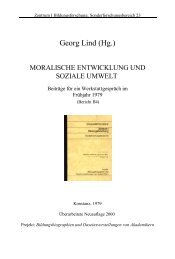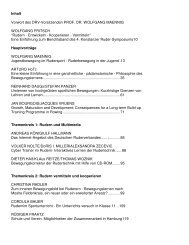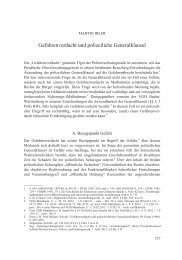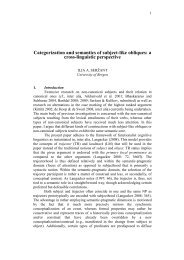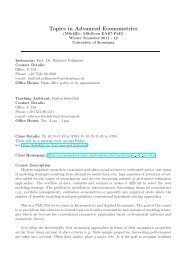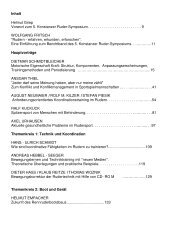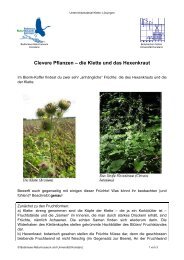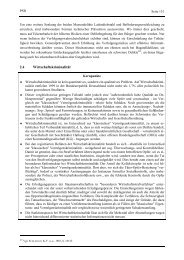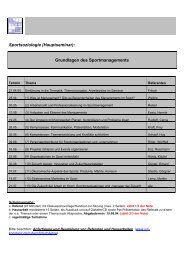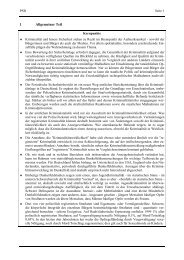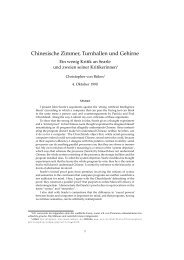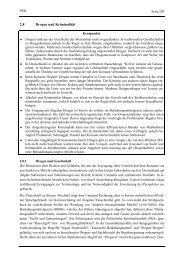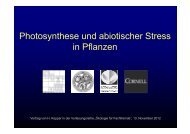Book of Abstracts Book of Abstracts - Universität Konstanz
Book of Abstracts Book of Abstracts - Universität Konstanz
Book of Abstracts Book of Abstracts - Universität Konstanz
Create successful ePaper yourself
Turn your PDF publications into a flip-book with our unique Google optimized e-Paper software.
A - 2<br />
104<br />
Gold Clusters with Density-Functional Based Tight-Binding Method<br />
Pekka Koskinen 1 , Hannu Häkkinen 1 , Gotthard Seifert 2 , and Michael Moseler 3<br />
1 Department <strong>of</strong> Physics, NanoScience Center, 40014 University <strong>of</strong> Jyväskylä, Finland<br />
2 Institut für Physikalische Chemie, TU Dresden, Mommsenstrasse. 13, 01062 Dresden, Germany<br />
3 Fraunh<strong>of</strong>er Institut für Werkst<strong>of</strong>fmechanik, Wöhlerstrasse 11, 79108 Freiburg, Germany<br />
In this work we employ the density-functional based tight-binding method (DFTB)[1] in the<br />
study <strong>of</strong> structures and energies <strong>of</strong> neutral and charged gold clusters. These clusters have been<br />
studied extensively with the density-functional approach (DFT), but for clusters <strong>of</strong> larger size or<br />
for molecular dynamics simulations <strong>of</strong> more complex structures one should have a more<br />
efficient yet accurate computational tool. In this work we demonstrate that this efficient method<br />
might indeed be a useful tool in the study <strong>of</strong> gold clusters.<br />
As an example, Fig. 1 shows the reproducibility <strong>of</strong> the relative energies <strong>of</strong> the isomers <strong>of</strong> Au - 7clusters,<br />
as compared with previous DFT studies [2]. Even better than the energy, the method<br />
gives mainly the same stable cluster geometries as density-functional calculations. The<br />
electronic structure is well described, as can be seen in the vertical detachment energies in Fig 2.<br />
The DFTB-method is able to show that the structure <strong>of</strong> the ground state <strong>of</strong> small gold anions<br />
transforms from two-dimensional to three-dimensional at approximately correct cluster size. We<br />
studied larger Au - 55-cluster isomers and found the same stable structures compared to previous<br />
studies, as well as reasonable isomer energies [3].<br />
Fig.1 Energies and structures <strong>of</strong> a few Au - 7-clusters.<br />
The energies are calculated with self-consistent<br />
charge (SCC) DFTB as well as with DFT and plotted<br />
relative to the corresponding ground state.<br />
References<br />
Fig. 2 The vertical detachment energies <strong>of</strong> the Au - 7clusters<br />
shown. The values are consistently lower<br />
than gradient-corrected DFT (GGA), and the error is<br />
<strong>of</strong> the same order than with local-density DFT<br />
(LDA).<br />
[1] M. Elstner, D. Porezag, G. Jungnickel, J. Elstner, M Haug, Th. Frauenheim, S. Suhai, and G.<br />
Seifert, Phys. Rev. B 58, 7260 (1998).<br />
[2] H. Häkkinen, M. Moseler, and U. Landman, Phys. Rev. Lett. 89, 033401 (2002).<br />
[3] H. Häkkinen, M. Moseler, O. Kostko, N. Morgner, M.A. H<strong>of</strong>fmann, and B.v.Issendorff, Phys. Rev.<br />
Lett. 93, 093401 (2004)



